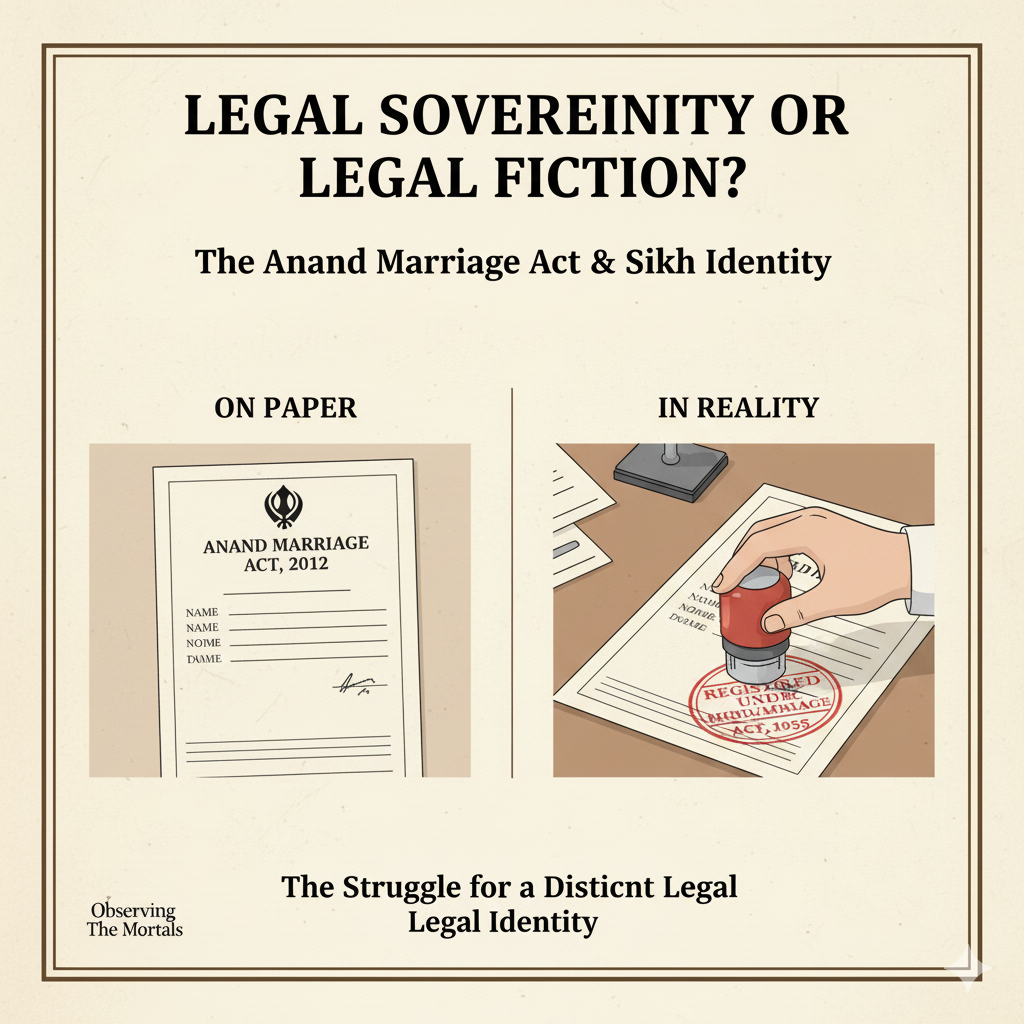The Anand Karaj is the sacred and distinct wedding ceremony that lies at the heart of Sikh tradition. For over a century, it has been legally recognized by the Indian state. Yet, a profound paradox remains: for millions of Sikhs across India, the official registration of their marriage often takes place not under their own law, but under the Hindu Marriage Act. A recent order by the Supreme Court, pushing states to finally implement the Anand Marriage Act, is the latest chapter in a long and complex struggle—not just for administrative convenience, but for the very soul of a distinct religious and legal identity.
The Information Box
Syllabus Connection:
- Paper 1: Chapter 4.3 (Legal Anthropology), Chapter 5 (Anthropology of Religion)
- Paper 2: Chapter 4 (Religion and Society in India), Chapter 8 (Social Change), Chapter 6.1 (Minority Issues)
Key Concepts/Tags:
- Anand Marriage Act, Legal Pluralism, Religious Identity, Sikhism, Personal Law, Supreme Court
The Setting: Who, What, Where?
This case study is centered on the Anand Marriage Act, a law first enacted by the British in 1909 to give legal sanction to the Anand Karaj, the Sikh marriage ceremony performed around the Guru Granth Sahib. Despite being amended in 2012 to include provisions for registration, the law has remained in limbo. The key actors are the Sikh community, which seeks a separate legal framework for their marriages; the Supreme Court of India, which is now intervening to enforce the law; and the 17 states and 8 Union Territories that have failed to frame the necessary rules for its implementation, forcing Sikhs to register their marriages under the Hindu Marriage Act, 1955.
The Core Argument: Why This Study Matters
This is not just a bureaucratic issue; it’s a profound case study on the gap between legal recognition and on-the-ground reality, driven by the politics of identity.
- The Great Implementation Gap: The central problem is a massive failure of governance. Despite a clear amendment to the Act in 2012 directing states to create rules for registering Anand Karaj marriages, the vast majority have simply not done so for over a decade. This highlights how a law can exist on paper but be practically non-existent for the citizens it is meant to serve, a classic case of an implementation gap.
- The Politics of Religious Identity: The struggle for the Anand Marriage Act is not merely about a different registration form. It is a deep-seated struggle for the legal recognition of a distinct Sikh identity. The Hindu Marriage Act, while secular in its application to various groups, legally clubs Sikhs, Buddhists, and Jains under the umbrella of “Hindu.” For many in the Sikh community, being forced to use this Act is seen as a form of cultural and legal assimilation that undermines their unique religious status.
- The Limits of the Law (A “Facade”): Even with the Supreme Court’s push, the current Anand Marriage Act has a major limitation. It only provides for the registration of a marriage. It lacks a comprehensive framework for crucial civil matters like divorce, maintenance, or succession. This means a Sikh couple could register their marriage under the Anand Act but would likely have to revert to the Hindu Marriage Act for a divorce, creating legal complexity. This is why a community leader has called the current law a mere “facade”—it offers symbolic recognition without full legal independence.
The Anthropologist’s Gaze: A Critical Perspective
- Legal Pluralism and the Homogenizing State: An anthropologist would see this as a classic case of legal pluralism, where a community’s distinct religious law struggles for recognition within the broader legal framework of the secular state. It demonstrates the state’s tendency to create large, convenient administrative categories (like the broad definition of “Hindu” in the HMA), a process that can inadvertently flatten the unique identities of minority groups.
- Law as a Symbolic Battleground: The fight over the Anand Marriage Act is a battle over symbols as much as it is over statutes. Having a separate, fully functional marriage law is a powerful symbol of a community’s distinctiveness and autonomy. The failure of the state to provide this is perceived not just as an administrative lapse, but as a denial of that symbolic status.
- Social Change and Rising Consciousness: The renewed push for the Act reflects a process of social change and rising identity consciousness within the Sikh community. It signifies a growing desire to translate a distinct cultural and religious identity into a distinct legal identity, moving away from a time when the status quo of using the Hindu Marriage Act was more passively accepted.
The Exam Angle: How to Use This in Your Mains Answer
- Types of Questions Where It Can be Used:
- “Legal pluralism in India presents both opportunities for diversity and challenges for the state. Discuss.”
- “Critically analyze the challenges faced by religious minorities in maintaining their distinct identity in India.”
- GS-2: “The debate around a Uniform Civil Code (UCC) requires a nuanced understanding of existing personal laws. Discuss.”
- Model Integration:
- On Legal Pluralism: “The challenges of legal pluralism are evident in the long struggle to implement the Anand Marriage Act for Sikhs. Despite its existence for over a century, the failure of most states to frame registration rules forces many to use the Hindu Marriage Act, highlighting the persistent conflict between a community’s distinct legal identity and the state’s homogenizing legal frameworks.”
- On Minority Rights: “The demand for the full implementation of the Anand Marriage Act is not just an administrative issue; it’s a crucial aspect of minority rights. For many in the Sikh community, being forced to register under the Hindu Marriage Act is perceived as a form of cultural assimilation that undermines their unique religious identity.”
- For a UCC Debate: “Any discussion on a Uniform Civil Code must consider the complexities of existing personal laws, such as the Anand Marriage Act. As critics point out, even this separate law is a mere ‘facade’ as it lacks its own provisions for divorce and succession, forcing individuals back into the Hindu legal framework and demonstrating the immense difficulty of creating truly independent and comprehensive personal laws.”
Observer’s Take
The long and frustrating journey of the Anand Marriage Act is a powerful story about what a law truly is. It teaches us that a law is not just a piece of text passed by a legislature; it becomes real only when it is implemented, accessible, and meaningful to the people it is meant to serve. The Sikh community’s struggle is a poignant reminder that in a profoundly diverse nation, the quest for recognition is as much about legal identity as it is about cultural practice. It challenges the state to move beyond symbolic gestures and create legal frameworks that genuinely reflect, and not just tolerate, the pluralistic fabric of Indian society.





